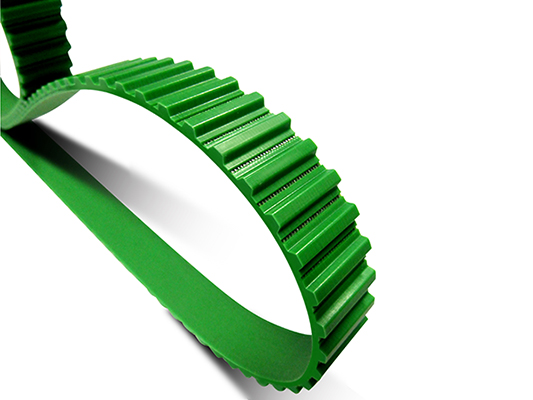Today’s trends in belting solutions keep goods moving to keep business moving.
Logistics, the complex web of coordinating, moving, and storing products, requires constant reinvention to keep pace with a quickly evolving marketplace. Today, companies across a wide range of sectors must align their logistics with overarching needs to maximize efficiency, improve inventory forecasting, and reduce carbon footprint. In recent years, we’ve seen a rise in automation and robotization of operations to support those priorities. As a result, today’s warehouses are significantly more sophisticated than even just a few years ago. Even across the varying needs of different companies, some common shifts are shaping a new generation of logistics and warehousing solutions that support resilience, speed, and sustainability. These include power transmission and conveying belts designed stronger, quieter, and more sustainably than ever before. And carrying the torch to continue this evolution is a greater capacity for customizable solutions that open new frontiers for improving how we move product.
Super-charged operations need super belts. Logistics professionals continuously look to automation to improve efficiency, lower costs, and reduce the physical demands on warehouse employees. How do these needs translate to conveying equipment? We see this in an increasing “need for speed” and durability in automated storage that has facilitated a shift from chains to woven belting, which can minimize downtime for repairs of broken links. However, the shift is much more far-reaching than a simple material swap.
In the high-speed, high-precision, and often harsh environments of today’s increasingly sophisticated warehouses, any equipment failure doesn’t just result in unexpected maintenance downtime but potential danger to the facility and operators. These operations demand belt attributes like superior material strength, friction resistance, and impact resistance. A good embodiment of all these attributes is Ammeraal Beltech’s Flexam Hybrid belt — constructed with a standard solid woven top surface and the brand’s famously superior EX fabric on the bottom — for a conveyor belt that is flame-retardant, and tear-resistant with lace retention that can pull heavy loads while offering excellent lateral stability, so product doesn’t shift.
Even amid the rise of dark warehouses, it’s important to remember that most facilities will still require a workforce—and that workforce requires a safe, comfortable environment. Continuous exposure to the loud noise of heavy equipment can cause hearing loss and conditions like tinnitus. To prevent these scenarios among facility operators, supervisors, and other workers, low-noise belting solutions can help to minimize noise pollution and need for uncomfortable hearing protection. Additionally, it’s important to ensure worker convenience and minimize strain in increasingly large warehouses that span acres. Conveyor and power transmission belts significantly reduce taxing physical strain that can contribute to injury for workers and decrease distances walked which effectively free up their time for more value-added tasks.

Many companies aren’t just trying to improve the bottom line by gaining efficiency. They are also looking to minimize the carbon footprint across their supply chains. To align with company sustainability goals, belts can be designed to minimize energy consumption. Additionally, belts can be designed with recycled or renewable materials.
One example is AMMEGA’s MEGALINEAR MegaEco Biobased belt for power transmission applications. It is produced with polymer partially derived from vegetable sources, contributing to a lower carbon footprint compared to belting solutions made from fossil-based materials to support Tier 2 or Tier 3 supplier sustainability goals. Of course, sustainability isn’t sustainable unless it’s practical. The strength and cold-temperature tolerance of this power transmission belt makes it a great fit for vertical farming and large, automatic warehouse spaces that operate at low temperatures.
Another interesting project led by AMMEGA is their conveyor belts with fabrics obtained from PET bottles. Until now, fabric production for belts required virgin polyester. AMMEGA has evolved to use recycled polyester through a process that involves the collection of PET bottles and turning them into fabrics, which can be interwoven into the structure of the belts. Such a procedure significantly reduces carbon dioxide emissions and requires less water and energy, which will soon be integrated across industries.
Despite these common threads across wide ranging logistics operations, there is no one-size-fits-all belting solution. There are nearly infinite nuances across the needs and realities of transporting food, medicine, consumer electronics, heavy machinery, bulk solids, etc. For example, the food sector prizes ease of cleaning to meet stringent food safety requirements that require frequent sanitization, making polyurethane belts a better choice over rubber belts. For the manufacture and logistics of semi-conductors, antistatic properties are the priority. For consumer electronics, the need for low-wear belting solutions that help minimize the potential for dust and particle contamination is critical. The more exacting logistics professionals can be in specifying their needs, the more their belts can support them.
Whatever the application, conditions, or customer needs, the most critical factor in designing the right belting solution is close collaboration. AMMEGA, a global provider of conveyor belting and power transmission solutions, recently invested $100 million to boost U.S. innovation, production, and warehousing through their Built American Proud initiative, is developing custom belts for its customers across industries. Apart from improving durability, AMMEGA is focusing on dynamics of their belting machines: shifting towards quicker acceleration of belts, with a higher number of circulations. This “need for speed” challenges belt manufacturers like AMMEGA to create low-energy and low-noise solutions to make work environments equally as efficient as pleasant.
To learn more, visit AMMEGA’s Aameraal Beltech and Megadyne businesses for conveyor belting and power transmission, respectively.
About the Authors:

Bobby Bauman is the Director of Product Management at Ammeraal Beltech, where he has been instrumental in shaping the company’s product strategy since July 2021. With over 19 years of experience as the Sales Manager in the conveyor belting industry, Bobby brings a wealth of knowledge in sales and product development to his current role. His strategic vision and leadership have contributed to Ammeraal’s success over the past 4 years, highlighting his commitment to excellence and innovative thinking in the field of product management.

James Hoshiko is the Director of Product Management at Megadyne. He is a forward-thinking leader with 20+ years of product line marketing and management experience across multiple industries, including aerospace, defense, automation, packaging, unit material handling, and food and beverage. He has been recognized for driving growth, by coordinating teams to collaborate closely on process optimization and other projects, and acknowledged for generating significant sales opportunities both directly and through channel partners.
In this episode, I sat down with Beejan Giga, Director | Partner and Caleb Emerson, Senior Results Manager at Carpedia International. We discussed the insights behind their recent Industry Today article, “Thinking Three Moves Ahead” and together we explored how manufacturers can plan more strategically, align with their suppliers, and build the operational discipline needed to support intentional, sustainable growth. It was a conversation packed with practical perspectives on navigating a fast-changing industry landscape.